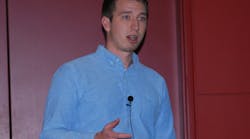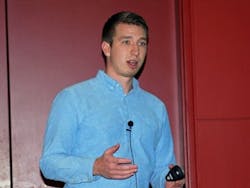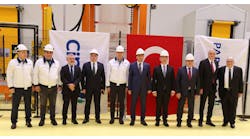“We wanted to move from islands of automation to a ‘single pane of glass’—a single graphical interface to show status and control the entire facility.” Taylor Hermes of Ahlstrom-Munksjö discussed the Wisconsin paper mill’s control system modernization project.
Plants dream of having a single view into all their systems, with the ability to not only operate everything from one dashboard, but to drill down and see what’s happening on individual equipment, instruments and networks, and built-in diagnostics so operators can identify and solve problems quickly and easily. Even in the middle of the night.
That dream seemed especially remote at Ahlstrom-Munksjö’s Thilmany paper mill in Kaukauna, Wisconsin, where a hodge-podge of systems acquired over decades needed plenty of attention just to keep the plant running. But a project completed in October, 2019 with Rockwell Automation to move the digester from a dated Foxboro I/A system to Rockwell Automation’s PlantPAx DCS has opened a path to “a single pane of glass.”
The Thilmany mill is an integrated pulp and paper facility producing a full line of products from paper to tape and medical devices. It was equipped with a number of systems and various degrees of automation in its woodyard, power house, water treatment, wastewater and five paper machines.
“We wanted to move from islands of automation to a single pane of glass—a single graphical interface to show status and control the entire facility,” said Taylor Hermes, electrical engineer, Ahlstrom-Munksjö, who presented with David Vukosich, electrical engineer, Ahlstrom-Munksjö at Rockwell Automation’s Process Solution User Group (PSUG) event this week in Chicago.
“Our HMIs [human-machine interfaces] are for operators only, not maintenance and engineering, who also need information. We have multiple systems passing data back and forth. There are separate systems for drives, controllers and proprietary I/O networks, with a separate network, computer and software for each,” said Vukisich. “We want a single view for everyone.”
Why PlantPAx?
“When you’ve been around a while, you’ve seen a lot of stuff and do a lot of stuff,” Vukosich said. “Over time, everybody ends up with a set of favorite tools, a war chest of goodies, adding some and discarding the ones that aren’t as good. We’re constantly retooling, cutting and pasting, and redeploying.”
But they were tired of one-off solutions. “We wanted a single place we could call and ask questions, a manual and training support, not tribal knowledge and reliance on tech support,” Vukosich said. “In PlantPAX, the tools are free, we didn’t have to purchase anything extra. We have add-on instructions (AOIs) and add-on profiles (AOPs) to bring in a wealth of diagnostic data—a wave of information coming at you. And it has faceplates for maintenance and engineering.”
They had tried PlantPAx functionality on a compressor that was overheating, and were able to look at the temperatures. It was low-cost solution--not the full DCS—but they identified the problems, rolled it out to other compressors, and built a library with a small PanelView.
“Then we used it on a larger application on a brown stock washer, where it started out as controls for chemical additions, and now runs the whole thing,” Hermes said. “Being able to play with it this way made us amenable to using it as a solution for the whole facility, and it was already familiar to many of our people.”
Young engineers "are able to sit down and grab the tools, they don’t have to go to school for two weeks just to get started,” Vukisich said. “And OEMs are starting to use it, so it’s coming in with the equipment.”
They found that on individual equipment, with a single pane of glass, they could network variable frequency drives and controllers, add produce/consume tags to downstream processes, and perform hardware triage from an operator screen. Operators could now participate in troubleshooting via the advanced diagnostics available on their HMI.
Over time, they added PlantPAx to many separate pieces of equipment and in 2018, they used it on the digester in partnership with Orion Group as a system integrator. And they replaced a Foxboro I/A system from the 1980s with PlantPAx. The result is I/O cabinets that are clean and neat, using the same hardware deployed elsewhere in the plant so spares are already stocked. It uses the same software tools that the electrical engineers and technicians already use, with the same Rockwell Automation support tools (TechConnect and Knowledgebase) and the same Werner Electric technical support.
“The I/A system had been through a lot, and we were having scheduling problems due to reliability,” Hermes said. “We wanted a complete upgrade. We went from steam packing to liquor packing—I think we were one of the last paper mills on Earth to do that.”
The digester with Orion was their opportunity to make a real change, not just new hardware and the same system. “We told everyone this was done in 1986, now it’s 2018 so ‘bring out your dead,’” Vukosich said. “Not every project needs a redesign, but it’s the time to consider it.”
Enable the single pane
The Internet of Things (IoT) unlocks the single pane, and it starts with a robust network design. “We standardized on Cat 6 copper and OM3 fiber,” Vukosich said. “We put in a lot more fiber optics, and Ethernet everywhere—Ethernet is the driving force of integration.” The switches must be managed, and best practices must be followed.
“Everybody wants to sell you an Ethernet product or service, or both. Hook it up and it works,” Vukosich said. “Topology is important—redundant star, device ring—and you need to decide the best way, which can be different in different areas. That’s OK. But do pick a way, and stick to it.”
For cybersecurity, “we’re doing defense in depth, with unused ports plugged and connectors locked,” Vukosich said. “And, in our plant, the Ethernet wiring is color-coded. IT doesn’t use white, so I do.”
Now, from their single pane of glass, they can interrogate I/O, get network status and do diagnostics from a scalable, low-cost solution, configurable from the HMI. It has similar code structure for the maintenance HMI, and similar look and feel for operators as they move across the facility.
“We already had PlantPAx on the washer,” said Hermes. “Our new operators start at the washer, that’s our line of progression, so most of the operators are already familiar with it.” Much of the hardware is the same used elsewhere in the plant, and is already stocked as spares. It uses the same software tools the engineers and technicians already have.
Now they can build out from the digester, integrating more systems using the same tools. “We no longer feel we’re stuck,” Hermes said. “We can really build out and grow from this project.”
The editors of Control are on-site at Automation Fair 2019 to bring you breaking news, innovations and insights from the event. Once the event is over, they will put together a report featuring the top news. Pre-order your copy today.






